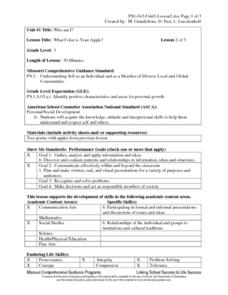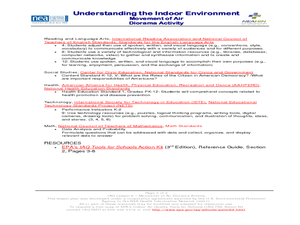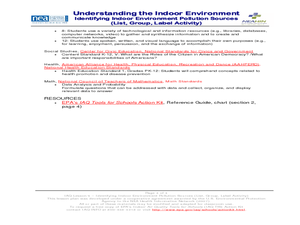Curated OER
Soil in My Food Web
Fourth graders understand the importance of soil to the food web. In this food web lesson, 4th graders create various food webs beginning with soil using yarn and name cards. Students write about the importance of soil to one...
Curated OER
Sunlight and Warm Air
Students examine the different ways heat can be felt. For this radiation and conduction lesson, students recognize that the sun radiates heat. Students conduct three experiments to find how the sun warms the Earth and how that heat...
Curated OER
What's in the Soil?
Fourth graders examine soil to find its contents, and how much water and air they can measure. In this soil composition lesson plan, 4th graders perform three experiments and record their results. In one experiment they...
Curated OER
Caring for the Land
Fifth graders examine how to care for the land. In this soil management lesson, 5th graders participate in a service learning project and assist in the preservation of natural resources.
Curated OER
A Bug's Life: Diary of an Insect's Metamorphosis
Fifth graders examine the stages of insect's to understand heredity. In this inherited traits lesson, 5th graders explore the life of the honeybee for its inherited traits. Students recognize the difference between inherited traits...
Curated OER
Creeping and Crawling Observing Mealworms and Earthworms
Students observe the inherited traits in earthworms and mealworms. In this organisms lesson, students view a live mealworm and earthworm on a tray and identify the body parts. Students measure the worms and observe the behavior....
Curated OER
Paint's Family Tree
Students sort and classify the genetic traits of horses. In this heredity and genetics activity, students read dialogue in a skit in which specific physical traits of several horses are described and a horse family tree is created....
Curated OER
Now You Have It, Now You Don't
Sixth graders compare corn-based shipping peanuts to Styrofoam shipping peanuts. In this hands-on environmental awareness lesson, 6th graders try dissolving two different types of packing peanuts in water.
Curated OER
Hand Washing: I can handle it!
Sixth graders examine microorganisms. In this germs instructional activity, 6th graders observe and record data on the positive and negative aspects of microorganisms. Students complete activities, view a film, and explore...
Curated OER
Microbe Experimentation
Sixth graders conduct a microbe experiment. In this microbe lesson, 6th graders develop an experiment with micro-organisms, complete the associated worksheet, and complete a table showing the results.
Curated OER
What Color Is Your Apple?
Third graders spend time identifying the characteristics they have and ones they would like to develop for their own personal growth. As a class, they brainstorm ways they can tell they are growing up or being mature. Individually, they...
Curated OER
Be a Problem Solving Star
Third graders observe a math problem and discuss what it is and what they should do with it. They are introduced to the STAR steps for problem solving and discuss how to use it to answer math problems as well as incorporating some of the...
Curated OER
Respecting Differences
Fifth graders brainstorm what a relationship looks like in which both people respect each other. After completing a worksheet, they discuss the importance of respecting other beliefs. To end the lesson, they identify things they can do...
Curated OER
Red Hot Resume
Students listen to a "Help Wanted" story, paraphrase the story, and discuss vocabulary. After reading the story again, students complete a worksheet replacing the vocabulary words with their own words so that the story makes sense to them.
Curated OER
Community Wellness Fair
Twelfth graders list ideas to create a wellness fair. They form student committees to organize times for each class to participate in the fair. Students assist in setting up the fair by putting up tables for the exhibitors, preparing...
Curated OER
I Really Love This More
Young language arts learners choose between two activities and then attempt to convince their classmates of their choice as a way of practicing persuasive speech. This particular activity uses Valentine's Day as a theme; learners chose...
Curated OER
What Must Be Done To Achieve Equality?
Students evaluate various statements about what must be done to achieve equality for lesbian, gay, bisexual, and transgender persons, students consider the responsibility they have to end discrimination. They also explore the relative...
Curated OER
Gingerbread Baby v. Gingerbread Boy #7
Students read two stories. For this comparison lesson, students read "The Gingerbread Baby," by Jan Brett and the original "Gingerbread Boy." Students use a Venn Diagram to compare and contrast the two stories.
Curated OER
Using the Problem Solving Wheel
Students solve problems about air quality. In this air quality lesson, students receive a scenario from the problem wheel and find solutions to the air quality problem. Students write a paragraph summarizing what they learned.
Curated OER
Movement of Air Diorama Activity
Students make a diorama to illustrate the process of mechanical airflow. In this movement of air lesson plan, students discuss ventilation and air movement indoors. Students discuss ventilation systems and study pictures of the systems....
Curated OER
Movement of Air Mind Map Activity
Students explore the movement of air. For this air lesson, students discuss and give examples of air ventilation. Students compare outdoor and indoor air quality. Students create mind maps as a visual representation of...
Curated OER
Understanding the Indoor Environment: The Movement of Air
Students discuss HVAC to assess prior knowledge. Students create a rubric to assess their modals of HVAC units, and build the models according to instructions and discussion by the teacher.
Curated OER
Identifying Indoor Environment Pollution Sources (List, Group, Label Activity)
Learners identify the cause of indoor air pollution. In this indoor air pollution lesson, students list, group, and label sources of indoor pollution. They brainstorm a list of all of the indoor pollutants they can think of before...
Curated OER
Understanding the Indoor Environment:Preventing and Fixing Indoor Air Pollution
Pupils explore air pollution. In this environmental studies lesson, students work with a partner to create a Venn diagram comparing and contrasting possible solutions to prevalent indoor air pollution problems. Pupils discuss...

























